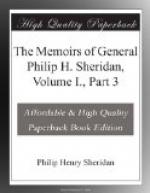The battle was a decidedly severe one, the loss on each side being heavy in proportion to the number of troops engaged. This fight took place almost immediately in front of our infantry, which, during the latter part of the contest, was busily occupied in throwing up intrenchments. Late in the afternoon I reported to General Meade the presence of the enemy’s infantry, and likewise that Hampton’s and Fitzhugh Lee’s divisions were in my front also, and asked, at the same time; that some of our infantry, which was near at hand, be sent to my assistance. I could not convince Meade that anything but the enemy’s horse was fighting us, however, and he declined to push out the foot-troops, who were much wearied by night marches. It has been ascertained since that Meade’s conclusions were correct in so far as they related to the enemy’s infantry; but the five cavalry brigades far outnumbered my three, and it is to be regretted that so much was risked in holding a point that commanded the roads to Cold Harbor and Meadow bridge, when there was at hand a preponderating number of Union troops which might have been put into action. However, Gregg’s division and Custer’s brigade were equal to the situation, all unaided as they were till dark, when Torbert and Merritt came on the ground. The contest not only gave us the crossroads, but also removed our uncertainty regarding Lee’s movements, clearly demonstrating that his army was retiring by its right flank, so that it might continue to interpose between Grant and the James River; as well as cover the direct route to Richmond.
General Lee reported this battle to his Government as a Confederate victory, but his despatch was sent early in the day, long before the fight ended, and evidently he could not have known the final result when he made the announcement, for the fight lasted until dark. After dark, our own and the Confederate dead having been buried, I withdrew, and moving to the rear of our infantry, marched all night and till I reached the vicinity of Old Church, where I had been instructed to keep a vigilant watch on the enemy with Gregg’s and Torbert’s divisions. As soon as I had taken position at Old Church my pickets were pushed out in the direction of Cold Harbor, and the fact that the enemy was holding that point in some force was clearly ascertained. But our occupation of Cold Harbor was of the utmost importance; indeed, it was absolutely necessary that we should possess it, to secure our communications with the White House, as well as to cover the extension of our line to the left toward the James River. Roads from Bethesda Church, Old Church, and the White House centred at Cold Harbor, and from there many roads diverged also toward different crossings of the Chickahominy, which were indispensable to us.
The enemy too realized the importance of the place, for as soon as he found himself compelled to take up the line of the Tolopotomy he threw a body of troops into Cold Harbor by forced marches, and followed it up by pushing a part of this force out on the Old Church road as far as Matadequin Creek, where he established a line of battle, arranging the front of it parallel to the road along the south bank of the Pamunkey; this for the purpose of endangering our trains as they moved back and forth between the army and the White House.




